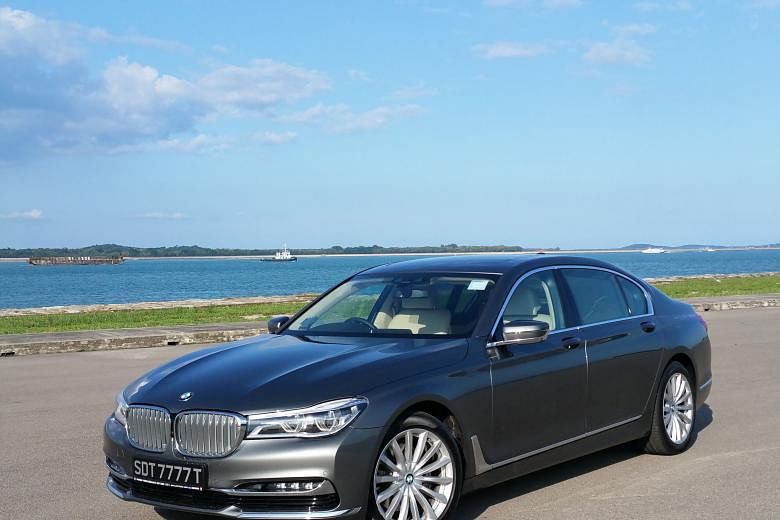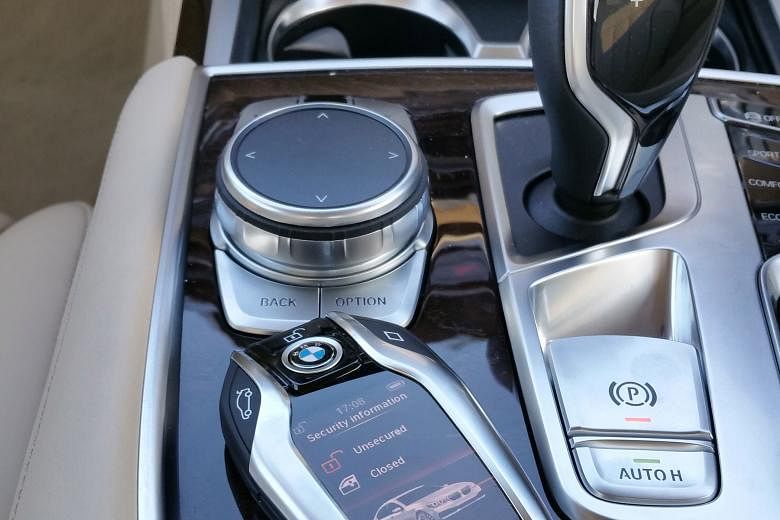The old adage about BMWs being cars for drivers and Mercs being cars for the driven still holds true if you compare the latest 7-series with its stellar competitor.
Despite all the gadgets and gizmos BMW has thrown into its flagship, it is still the person behind the wheel who gets the most enjoyment from it. And it is not a bad thing, since this is the one distinguishing factor between the 7er and the Mercedes S-class.
With that all-important piece of information out of the way, here are six other things you need to know about the latest 7-series, distilled from the reams of literature on what is easily the most high-tech limo available today.
The Force: You can control the infotainment system with Jedi-like hand gestures. Unlike similar functions available in other cars, the sensor in the BMW is very sensitive. Perhaps a tad too sensitive, as it is often hard to fine-tune the volume of the radio, for instance.
-
SPECS / BMW 740Li
-
Price: $456,800 with COE
Engine: 2,998cc 24-valve inline-6 turbocharged
Transmission: Eight-speed automatic with paddle shift
Power: 326bhp at 5,200rpm
Torque: 450Nm at 1,380rpm
0-100kmh: 5.6 seconds
Top speed: 250kmh
Fuel consumption: 7 litres/ 100km
Agent: Performance Motors
There is no need to seek Yoda for help, though. There are other ways to control the car - via steering- mounted switches, its iDrive system and physical switches on the console itself.
There is also a touch tablet in the rear centre seat, which a 20something tech tycoon could control myriad functions with - from the car's massage seats to tracking its fuel efficiency. Sorry, there is no Wi-Fi, though.
A smart key lets you check on the vehicle's status, turn on the ventilation remotely and, of course, lock/unlock the car. This key is almost the size of a small mobile phone and, like all mobile phones, it needs to be recharged. It is a pity BMW does not provide wireless induction charging in the car.
Let there be light: The car is practically a mobile disco, with an LED-embedded panoramic glass roof, LED ambient lighting emanating from fascia, footwells and doors, and a vast "welcome light carpet" that lights up the floor around the car in a graphic format. You can choose from various colours for the first two lighting functions. Oh, laser headlights are also an option, if you feel LEDs are too common.
View to a cue: 3D surround view projects the car and its surroundings onto the centre monitor, giving you unparalleled visibility. You may find it a little too overwhelming, especially when the top view is also projected onto the screen.
If you still find it hard to park with all these visual cues, you can let the car do it for you. When a parking space (parallel or perpendicular) is detected, just indicate which side it is on, hold down a park button and let the car do everything else.
It is in the navigation system that 3D projection becomes really useful. You can see the street and surrounding buildings. And if you wish to go to a particular building, just touch it on the screen. There is no need to input the address.
Carbon intensive: The new 7er's skeletal structure is made of steel, aluminium and carbon-fibre- reinforced plastic. It is the first car in its segment to have carbon in its core, which helps it shed 130kg (at 1,845kg, it is the lightest car in its class) while maintaining body rigidity. This, in turn, contributes to the driveability of the car.
Speaking of carbon, the car supposedly emits 164g/km of CO2, putting it in the neutral band of the carbon emissions-based vehicle scheme. Its stated fuel consumption is 7 litres/100km, but 12 litres is more realistic - which is not too shoddy for a limo equipped with a 326bhp engine (6bhp more than its predecessor) and which hits 100kmh in 5.6 seconds (0.1 second less than its predecessor).
Smooth operator: Chassis construction boasts a two-axle self-levelling air suspension system. At high speeds, this lowers the car by 10mm automatically. If you need to negotiate a steep ramp, you can raise the car by 20mm.
The suspension can also anticipate changes in road surfaces well ahead and, if necessary, beef up damping to iron out tarmac creases. But frankly, the benefits of this feature are not apparent.
There is also electromechanical active roll resistance, which keeps the luxe barge on an even keel even when it is aggravated.
Size matters: At 5,238mm, the car is 19mm longer than its predecessor. Width is unchanged at 1,902mm, while the height is lowered by merely 2mm - despite the car sitting 17mm closer to the tarmac. That means the cabin offers more headroom. While its wheelbase is also unchanged at 3,210mm, it is 45mm longer than its Mercedes rival's.
Rear occupants will find the legroom more than adequate, so an optional feature that moves the front passenger seat away to facilitate a barber's chair configuration for the towkay is not really necessary.
Despite its size, the 7-series handles itself like a top student in a deportment class, thanks partly to all-wheel steering. This allows the driver to exploit its sterling sixcylinder turbo with nearly as much abandon as in a 3-series.


